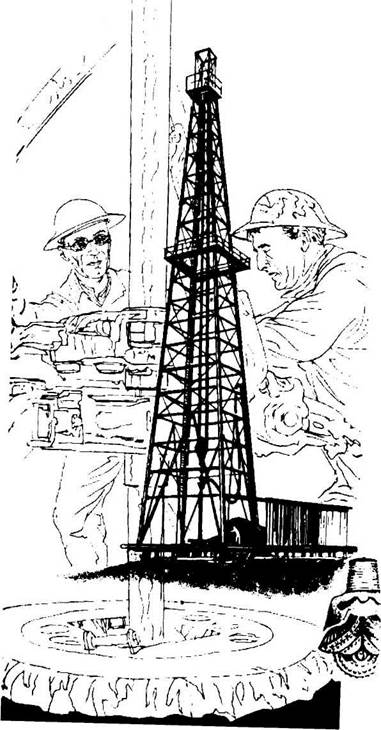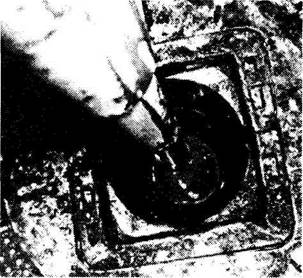Rotary Drilling
Today most wells are drilled by the rotary method, invented in the 1890's. In hard rock and in very deep wells, rotary drilling works better than cable-tool drilling. In the rotary method, a "string" of drill pipe -that is, sections of steel pipe screwed together by an augur bit at the lower end - is lowered into the hole. The top end of this drill-pipe string is coupled to the lower end of a heavy steel bar called the grief stem or kelly. The grief stem runs through a hole in the middle of a heavy steel turntable or rotary table to a swivel block that hangs from the crown block high up in the derricks When the driller is ready, the engineer starts the engine, a belt or chain drive from it turns the rotary table, and the grief stem/kelly and drill pipe also begin to revolve. The drill bit in the bottom of the hole revolves too, and the sharp teeth chew through the rock. Drilling for Oil
Chapter Three
With the rotary-type drill, left, men have reached some 25,000 feet or nearly 5 miles below ground. It bores through dirt and rock like a huge carpenter's bit and brace. As the hole deepens, sections of pipe are let down to line it and protect against cave-in. These are called casings. This important idea, which makes today's drilling possible, was first used by Drake, who is supposed to have thought of it while gazing down at the shape of his stovepipe hat. He was worrying about water filling his well as it grew deeper and deeper, and suddenly thought this pipe the shape of his hat might be just the thing to line the hole. What is Mud? Mud plays an important role in rotary drilling - not just ordinary mud, but a special kind of clay, water, and certain chemicals, mixed together in just right proportion. This mud supply is called a slush pond. A hose from the slush pond is coupled to the swivel so that mud can be pumped through it, down a hole in the centre of the grief stem, and so down through the drill pipe to the bit. As soon as the drill begins to cut, big slush pumps force the mud from the slush pond through the hose and down the drill pipe. By heavy pressure, it is pushed out through small holes in the cutting bit. This' keeps the bit cool. The mud is then forced back to the surface, carrying with it the rock cuttings. As it goes upward, it plasters the inside of the hole with dried mud, which is so tough that it often prevents caving without the use of steel casings. Drilling for Oil
Here you are looking into the mouth of a drill hole in Illinois, U.S.A., and can see the mud which is so important in drilling today. Drilling mud is a mixture of water, special clays and chemicals. It is pumped down through the hollow drill pipe, forced through small holes and brought back to the surface in the space between the outside of the pipe and the walls of the hole. The mud serves three purposes. It greases and cools the bit. It washes rock cuttings to the surface and acts as a sort of plaster to prevent caving in. It also holds back gas, and water, helping to keep the well from "blowing out" in one of those early-day "gushers" we associate with oil strikes.
Chapter Three What Could Bo Don* If Bits Become Dull? Even the hardest bits soon become dull and have to be replaced. When this happens, the engine is stopped, couplings are unscrewed from the grief stem, and the drill pipe is pulled out of the hole by means of a cable running through the crown block at the derrick head. When the string of pipe is raised as high as the height of the derrick allows, huge jaws grip it tightly, and the section above ground is unscrewed and lifted aside. Then the pipe is raised once more until another section is unscrewed. This is repeated until at last the bottom string comes up, and the bit can be replaced with a sharp one. Lengths of pipe are two, three, or four joints, called doubles, thribbles, and fourbles. When the new bit is in place the operation is reversed and the string is lowered back into the hole. Typical bits used in drilling for oil. Each type is suitable for use in penetrating different subsurface layers.
Drilling for Oil What is Cementing? 12 Most deep wells have to be lined with steel casing to help the ' there may still be a leakage through the joints of the casing; when this happens, a cement job is called for. A mixture of cement is poured down the pipe and forced by pressure out around the bottom of the pipe and back up the hole outside the casing. After this has set, the casing is usually well sealed and drilling can be resumed.
|




 This well in the middle of the countryside in France shows clearly the setup directly around a derrick. The pit in front is a mud hole. The use of mud in drilling is very important. A pit like this is called a slush pond.
This well in the middle of the countryside in France shows clearly the setup directly around a derrick. The pit in front is a mud hole. The use of mud in drilling is very important. A pit like this is called a slush pond.




